
If you’ve done a decent job with your product name or title, that is to say, if you’ve managed to grab your potential buyer’s attention by making a powerful first impression on them, it means they are just a click away from your product description. Well done so far!
The next thing you should do in order to maintain that convincing first impression of the product is to keep up the good work. Remember – your success is due to sheer hard work and a lot of practice.
All this sounds easier in theory, doesn’t it? However, what to do if you have to write about a product without sufficient details, for instance?
No worries! Watch the video below to help you approach the problem of writing about a product that doesn’t have much information. Also, you’ll be guided through some poor, average and exceptional real-life examples.
By comparing and contrasting them, you’ll quickly grasp the point and learn how you can empower a product page with excellent product descriptions.
You see? A good quality product page, which naturally includes a well-written product description, will help customers learn about the product and ultimately make a choice to purchase. In addition to impressing customers, Google will love it too.
By providing all the relevant necessary information, stores become more trustworthy and able to develop an ongoing relationship with the customers, which leads to a more profitable business.
That’s why you, as a future eCommerce copywriter, must be fully aware of the significance of a product page. It is the most important conversion page in any online store. It’s the point when the website visitors finally decide whether to click that BUY NOW button or leave the website.
In short, product pages are the lifeblood of every online store.
Because of that, every product in every store needs a unique product description. Remember – it must NOT be identical or even similar to any other website!
Therefore, in this lesson, you’re going to learn exactly what words and phrases you need to include in a well-written product description to make it the best possible. We’re going to present you with plenty of outstanding examples to learn from, and teach you about the features of top-quality product descriptions.
But first, let’s further explain to you why unique product descriptions are so critical for every online store. Here’s why we always point it out.
Importance of Unique Product Descriptions
Often, copywriters or store owners just copy and paste product descriptions directly from the manufacturer’s website. That means that these descriptions are NOT unique, which is not the best possible option.
This approach can sometimes save time and money in the short term but it puts these stores at a considerable disadvantage in terms of long term value, and it’s a fact every serious eCommerce copywriter MUST be aware of.
Thus, think twice before you do that. Is it really worth it? Especially when you KNOW the search engines and customers prefer unique descriptions of products.
Not only that, but they prefer descriptions that are useful, informative and well-written by a knowledgeable person. In order to achieve that standard, find out what you can do to write product descriptions that not only describe the product, but sell it.
With this preference in mind, Google introduced an algorithm change to their search engine initially called the Farmer or Google Panda update later. It was a change in the way their software indexes websites and was designed to weed out “copy and paste” content.
“This update is designed to reduce rankings for low-quality sites — sites which are low-value add for users, copy content from other websites or sites that are just not very useful. At the same time, it will provide better rankings for high-quality sites — sites with original content and information such as research, in-depth reports, thoughtful analysis and so on.”
Don’t you agree this comment from Matt Cutts, a Google employee, is a clear indication that Google prefers online stores that contain unique product descriptions?
Sure you do. But how do they know a piece of content is a duplicate? Let’s take a closer look and have a few more words on this since it’s significant for your future line of work.
What Does Duplicate Content Look Like?
Duplicate content is a repetition of phrases and sentences found on other websites.
Have a look at the below example product description from the OZtrail website. In particular, note the second bullet point text “Cross pole construction providing quick set up, greater strength and water shedding ability”.

If you go to Google and search for this exact phrase, it will yield tons of results i.e. a lot of repetition. Check it out.
This means that there are at least 2,000 other stores which are providing the same product information as the original manufacturer. You see the point?
Google will usually attribute the original writer of the information with the most credibility and push their website higher up in the search engine results. In our example, it looks like this.
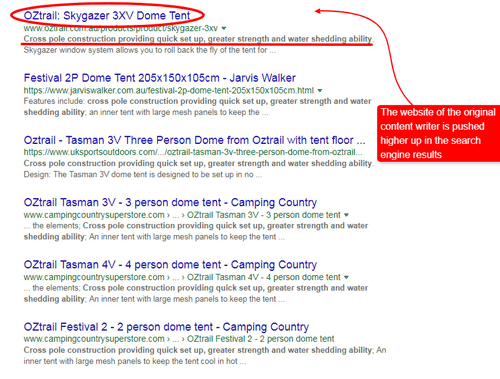
Consequently, the original writer will get the most visitors. Sounds logical, right? Think about it.
If 1,000+ online sellers have the same product information, how would customers choose who to buy from? It becomes a ‘race to the bottom’ where retailers end up competing on price alone. This then becomes a race to whoever can charge the least, and subsequently will push some people out of business.
Do you want to be responsible for your employer’s business failure? We doubt it.
The solution – and the option Google is trying to encourage – is to provide customers with more value.
An advantage to writing unique, interesting, informative, creative and enticing product descriptions is that your employer’s customers (and your employer, of course) will feel you are more trustworthy and knowledgeable about the products you are describing and they are selling or buying.
Customers want your insight as a product expert. They want to learn from you what makes a particular product the best one for them to buy.
People are in a hurry and they simply want to be told which product to choose over many other similar ones and why. That’s what they see as the actual purpose of a product description and page. Got it?
So, NEVER copy such content directly from the manufacturer’s or any other website, but create far better unique content instead.
Furthermore, to avoid the penalties imposed by Google Farmer/Panda update, make sure you create unique product descriptions for every single product in the store.
After all, the company itself claims their goal to be “to build user-friendly, high-quality websites that are worth linking to because they feature unique, frequently-refreshed content that adds value to a user’s experience”. Source: Google’s Farmer Update: 5 SEO Tips You Need Now
To dig deeper into this issue, you might want to read the following articles:
- Google’s ‘Farmer’ Algorithm and What It Means for Ecommerce SEO
- SEO Case Study: One Store’s Struggle with Google Updates
Also, here’s some more official information from Google taken from Search Engine Land: The Farmer/Panda Update: New Information From Google and The Latest from SMX West:
“Our recent update is designed to reduce rankings for low-quality sites, so the key thing for webmasters to do is make sure their sites are the highest quality possible. We looked at a variety of signals to detect low quality sites. Bear in mind that people searching on Google typically don’t want to see shallow or poorly written content, content that’s copied from other websites, or information that are just not that useful.
In addition, it’s important for webmasters to know that low quality content on part of a site can impact a site’s ranking as a whole. For this reason, if you believe you’ve been impacted by this change you should evaluate all the content on your site and do your best to improve the overall quality of the pages on your domain. Removing low quality pages or moving them to a different domain could help your rankings for the higher quality content.”
Nice. you definitely got it now. But perhaps you’re not the first and only person writing product descriptions in the online store you’re working for. Can you be certain some of your colleagues hasn’t made a mistake before?
Luckily, there is a way. Read on to find out.
How Can You Check if a Product Description Is Copied?
It is easy to check whether your content is unique or scraped. Duplicate content can be checked online using Copyscape and Plagiarisma. Isn’t that super convenient?
What’s more, if content has been scraped from somewhere else on the web, your Web Developers or Virtual Assistant will be able to file a Legal Content Removal Request with Google. Don’t you think it’s powerful?
Now when you’ve realised how important a unique product description really is, let’s deal with the features of a well-crafted one.
The Key Features of a High-Quality Product Description
Here’s what you need in order to write a successful product description that sells.
- A thorough understanding of the product and how it fits into the rest of the competitors’ products and others in the range – This means you will need to research the product online, as if you were a customer yourself.
- An ability to explain these differences from a customer’s perspective – This means you need to put yourself into the customer’s shoes, and truly try to understand the challenges they face in deciding which particular product best suits their needs and purpose.
- An ability to source various types of content and repurpose them for your store – This means you search deeply into the Internet, looking at many different sources so that you get a full understanding of the products you’re writing about.
- Check your spelling and grammar thoroughly.
When you have a good understanding of the products and the categories then you will be a good writer of product descriptions.
There are many places to learn about the product. As you start your research you will find that some sources are more reliable and useful than others (e.g. manufacturer’s website, online competitors’ stores, customer support emails, videos, forums, blogs and other sources where you can find discussions of people who have already used the product).
It’s time to dive deeper into each feature of a well-crafted product description now. Shall we?
Usefulness
Each product needs a good to-the-point summary or introduction discussing how it might be used, and who it is best for. This “sets the scene” for the customer. They can then feel whether they are looking at the right product or not.
The introduction should also point out a unique difference for a specific product compared to all others. Is this product bigger, smaller, cheaper, sturdier, lighter? Available in different colours perhaps? All these details help the customer to decide what exactly they want.
Here’s an example from Bed Bath and Beyond to illustrate what we mean by that.
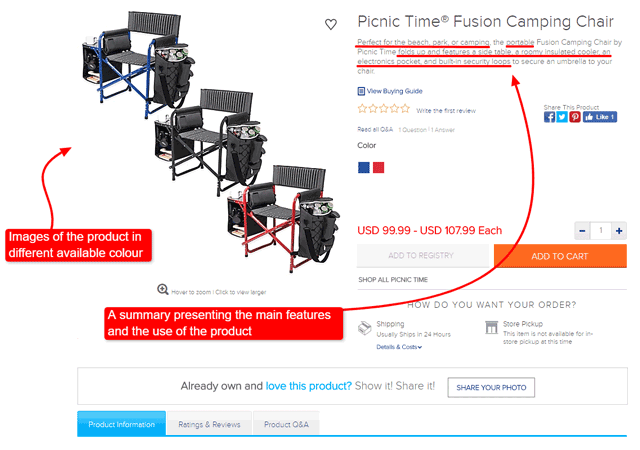
Easier to understand now? Of course.
Then, let’s get a bit more detailed for further clarification. Take a look at some more examples. For instance, the weight ratings of portable chairs mean they can be used for different purposes.
A lighter weight chair can be taken to e.g. a sporting game or a music festival, and will sit flatter in the back of the car, such as one of these:
Example 1A: Deluxe fabric folding camping chair, navy – lightweight, good for fishing or picnics
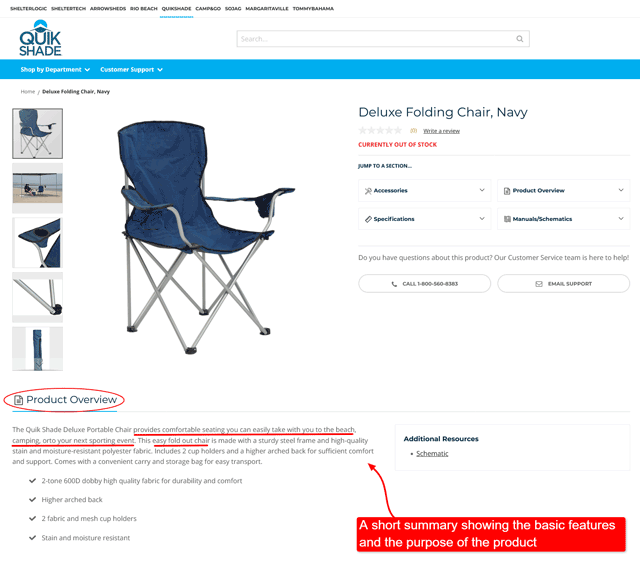
Example 1B: Stadium Seat – for sporting games or outdoor concerts
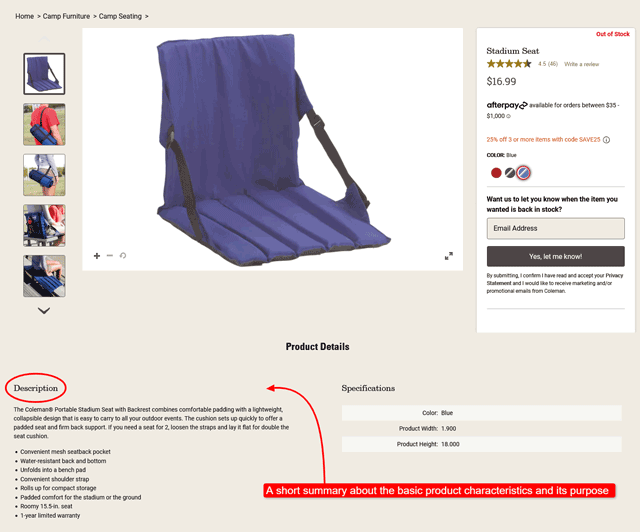
Whereas another chair might not fold flat, but could be sturdier and perfect for taking camping or hunting such as one of these:
Example 2A: 1/4-ton heavy duty folding camping chair, gray – more durable than 1a, suitable for camping
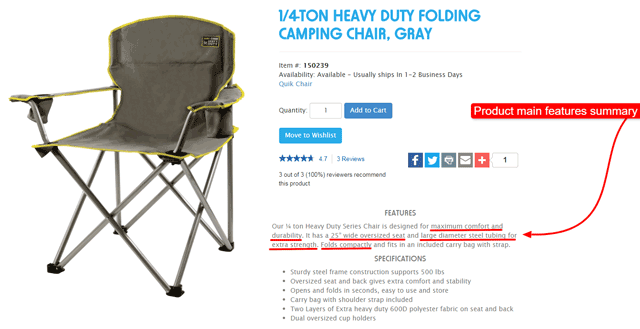
Example 2B: Strutter – perfect for hunting
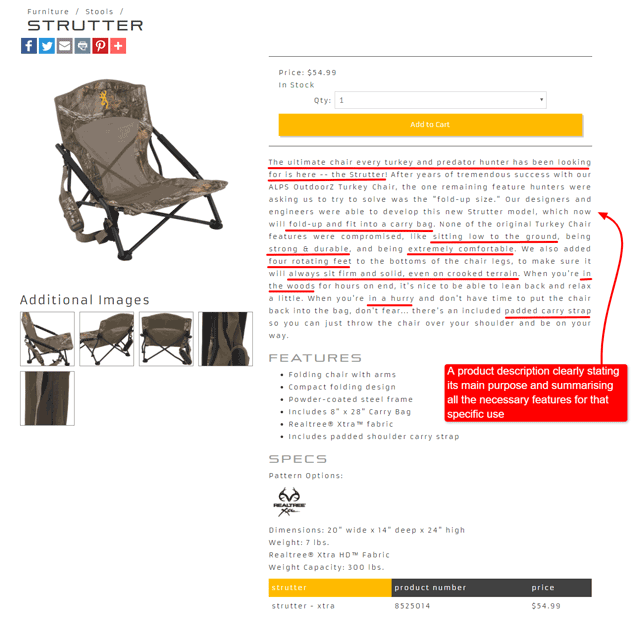
Now, when you’ve taken a closer look at these examples, you see why the product description should be more than just a list of features? Sure you do. Moreover, always make sure it anchors the online world to the real-world product.
Moreover, every product summary addresses the customer’s pain points, so it’s important to use it to point out how the customer’s problem can be solved with a particular product at the very beginning.
Now you’ve grasped the point, here’s a checklist for the product page summary, that is to say, some basic guidelines you will find helpful once you start writing this sort of content for an online store.
- It should be at least 30 words long, and more if possible. Get creative
- Include links to other compatible products within the store, if appropriate (e.g: link a product to popular accessories)
- Include links to content in the Blog and News sections of the store you’re writing for
- Possibly include comments/testimonials that you find from the customers on the web. For example, you might find someone in a forum saying “This is a great product because it is light and easy to carry”. You would copy their text and link back to their comment in the forum
- Also, include links to YouTube videos, if they are not published by a competitor (or to your store’s original videos e.g. on how to use your products if there are any)
- Include links to Product Manuals
- The text should be useful, creative, and friendly, but professional, without abbreviations or slang
- It should include keywords, but without keyword stuffing (too many synonyms)
- Avoid spelling mistakes and check grammar carefully
Not only should you tell customers about the purpose of the product, but you should present it clearly, which introduces the next feature we’re going to talk about.
Clarity
The introductory product summary we were discussing in the previous subsection should ideally be followed by the Features and Specifications lists. You can use technical terms in those lists, but that also needs to be summarised for the non-technical reader.
Namely, it is a good idea to write about more technical features and explain them in plain English so that every potential customer finds them clearly presented and easily understandable.
Again, it’s better to illustrate what we mean by this using examples. Let’s take a look how it could be done, shall we?
Here’s the OZtrail RV Jumbo Chair product page with both lists we suggested, although it lacks a good introductory summary part. Let’s take a peek at it.
Noticed the technical terms such as 600D in our example? How can common people know if that’s a heavy or light weight fabric? What does the D mean for an ordinary store visitor in search for a product like this one? Probably nothing.
That’s why a short explanation of what such terms mean and what they actually do to help the customers should always follow. Those explanations are highlighted in the screencast above.
Now, let’s check out another Shelta product page example, this time with a good summary part presented before the Features and Specifications lists.
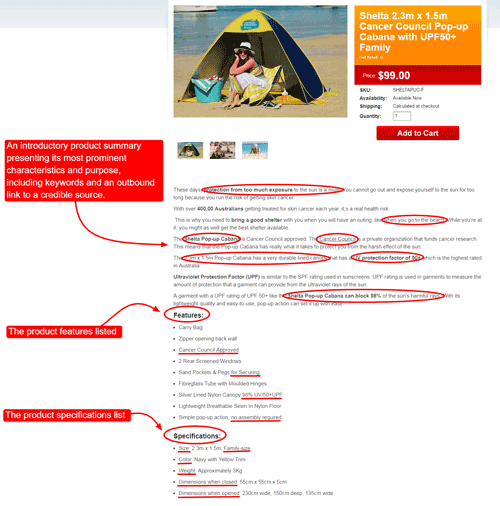
Doesn’t it help when you add a short comment such as “Family size” next to the technical details, 2.3m x 1.5m in this case? Sure it does! That’s what you should do.
It helps everyone immediately understand the product is big enough for the whole family without thinking about the numbers at all.
Now you get the gist, here are some more tips to remember when writing a features list:
- Most other similar products will also have a features list. You should research them on the Internet to make sure that you have the full feature list, with nothing missing that a competitor might have.
- Also, check the manufacturer’s website to make sure you have the most comprehensive feature list.
- Check the product on the Internet and write a list of ALL the features to compare.
- Check the product in shopping comparison engines.
- Understand what the technical jargon means and then interpret it for the customers. For instance, if you don’t know what “denier” means, then find out and include “denier” but also paraphrase so everyone else also understands it.
- Check all the competitors’ websites for new information that you do not have. But DO NOT copy and paste. Rewrite the text in your own words so it is not a duplicate.
By simply following these guidelines, you’re bound to succeed!
Furthermore, if you take a closer look at our previous example, you’ll see more ideas on what’s advisable to include in your product pages.
This one also includes a video guide on how to use the products, shipping and delivery information, as well as product reviews with the dates and names of the customers who have already used it. What’s more, those reviews have been gathered by the third party, which establishes trust.
This brings us to the next key feature of a top-quality product page.
Building Company Image
For building a positive company image and boosting trust among your online store visitors, it’s useful to mention if a product comes with free shipping.
Also, point out if the store offers a good returns policy, or that they’ve been in business for decades, or that they’re environmentally-friendly. All these and similar details make customers choose you over your competitors.
That’s why eCommerce copywriters don’t just write about the products in an online store, but take every opportunity to mention at least one positive aspect of the company as well. Thus, always be aware of what helps to build trust between the customer and the store, and make good use of it whenever it’s possible.
Again, let’s refer to our previous good examples from Gazebos Australia to illustrate this feature.
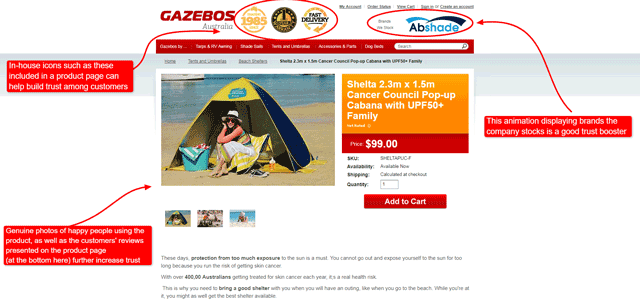
You see various trust builders scattered around this product page to promote the company? All those icons, animations, photos, reviews are not here by accident. They have a special purpose. Got it?
To learn much more about why building trust among your (potential) customers is immensely important and how to do it the right way, follow the link provided.
What other crucial characteristics a good product description must have? Let’s find out.
Readability
Writing a good quality description is only half the work. The other half is to apply good formatting that makes the content readable.
Jakob Nielsen is a famous usability expert. Check out his article How users read on the web. Although it was written in 1997, it is still highly relevant, so you’ll get a much clearer picture of what we’re saying here as soon as you read it and the other sources suggested here.
Also refer to Writing for the web to find out how to keep users on your product pages longer with the content which lends itself to skimming and scanning.
In a nutshell, most people visiting your product pages will NOT read the text carefully. Instead, they will skim-read.
To facilitate skim-reading it is important that the text is formatted appropriately. Here are some tips to follow:
- Highlight important words with bold. Don’t highlight every feature of the product. Highlight features that are unique to a particular product, or mark the product as different to competitors. Don’t highlight full sentences. Just highlight the main concept or idea in the sentence that you want a reader’s eyes to rest on.
- Use hyperlinks on important product names or concepts and take the reader to the other parts of the store. For example, if you are comparing a product to its smaller version, you would hyperlink the word “smaller” to the product page of the smaller product available in the store. If you are writing for a cooking product for instance, you could link out to a blog article with recipes within your store. More on hyperlinks later.
- Use one idea per paragraph. Use each paragraph to discuss one aspect of the product, then bold the essential idea within the paragraph so that it stands out.
- Use meaningful sub-headings to break up large blocks of content and to encapsulate one idea into each section containing carefully chosen keywords.
- Use the “Heading 2″ style. Do NOT use the “Heading 1″ style as this html tag is reserved for the product name or article name only.
- Start with the conclusion. What is the key point that you want your customers to know about the product? Start with that point. Provide a short but informative product summary at the very beginning explaining why the reader should buy that product. Usually the summary, or conclusion, is at the end of an essay or a story. At least, that’s what we’ve learnt at school, right? Forget about that here! Good product writing implies an inverted pyramid concept, whereby the conclusion is placed at the beginning.
- Use bullet lists to help readers skim-read through a bunch of ideas.
Now, let’s show you an example of a comprehensive yet readable product description within a real product page for the OZtrail Deluxe Gazebo. This is what it looks like:
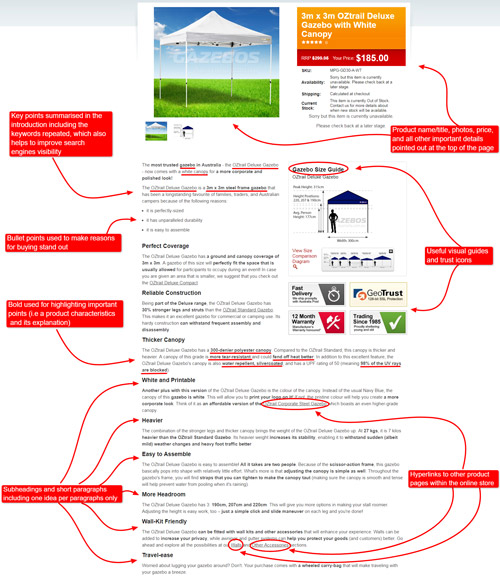
If you pay closer attention not only to the screenshot above, but to the whole example product page, you’ll learn a lot. Besides the key readability points presented above, you’ll see it’s a good idea to use e.g. a subsection on product care tips, warranty information, frequently asked questions, or suggest other related products.
Isn’t it always easier to learn from examples? Of course, it is. Then, why wouldn’t we explore some more real-life examples?
What Else Can You Do to Perfect Your Product Descriptions?
Let’s analyse additional remarkable practical examples and learn more from them. Ready to find out what else you can do to make your product descriptions shine? Here we go.
Get Creative With Your Descriptions
Don’t be afraid. You can go a bit wild with your descriptions. This example, which is a product description on a J. Peterman Company page, shows another approach.
They have introduced a sense of whimsy and conversation. This allows them to get very creative with their product descriptions, and provide more text than they ordinarily would be able to.
Isn’t the product name/title perfectly incorporated into this story?
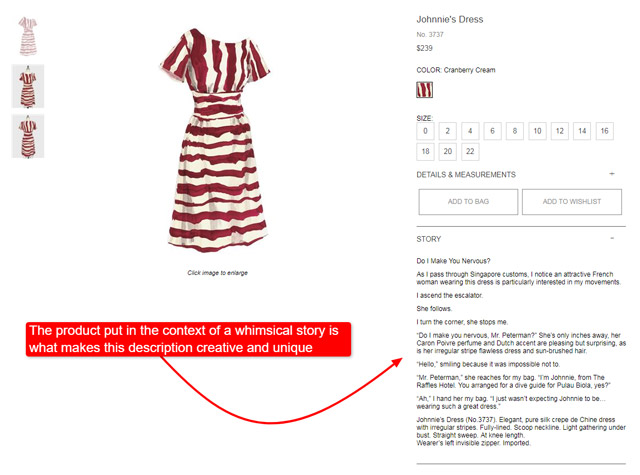
Don’t you think there’s so much you can learn exploring the other product pages within this online store, such as this one for a French Film Star Travel Dress for instance? Go ahead! You’ll be amazed.
These guys are creative both with product titles and descriptions, aren’t they?
Have a friendly conversation
In one of their product descriptions, the Patagonia team have used a conversational tone introducing the product, and then followed up with a list of features.
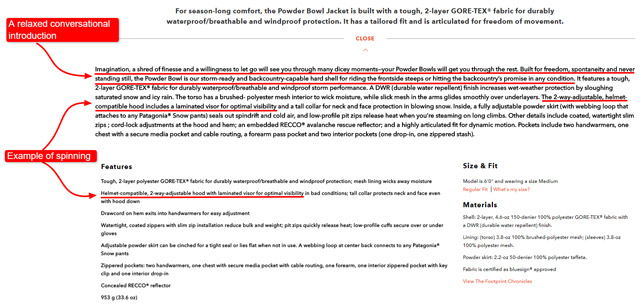
However, compare the second list point with the text inside the product description. The phrase “the 2-way-adjustable, helmet-compatible hood includes a laminated visor for optimal visibility” is very similar to “helmet-compatible, 2-way-adjustable hood with laminated visor for optimal visibility”.
This is sometimes referred to as article spinning – when text is essentially the same but reordered so it looks different. You should AVOID this approach as Google uses the Panda algorithm update to demote/delist websites involved in article spinning, remember?
Here’s a better example of a product description from J. Peterman Company again, you guess.
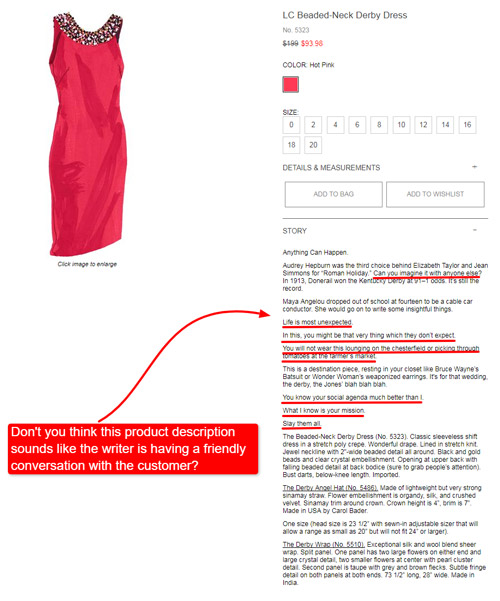
Don’t you think this sounds exactly like two close friends chatting? That’s the art of the copywriter having a friendly conversation with the customer we were talking about. You see?
However, to talk to your customers so that they really understand your message, you must speak their language.
Speak Your Customer’s Language
Malucchi crafted this simple but attractive product description for very stylish dog collars.
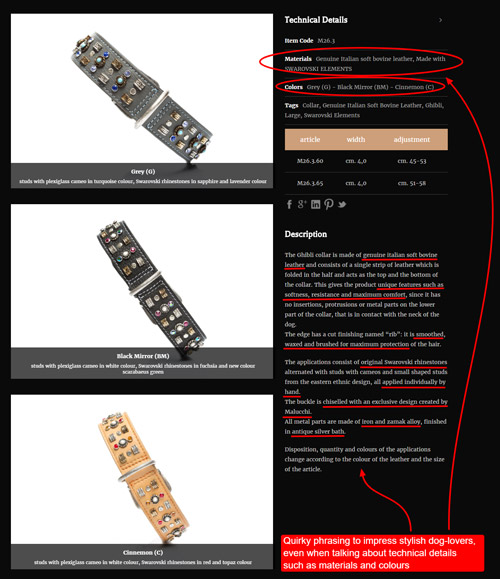
Apparently, their target customers are stylish dog-lovers and they’ve used catchy and quirky phrases to make the product description more interesting, fun, and appealing to their customers.
Technically, the terms they’ve used to describe the products are the colors available (grey, black mirror, cinnamon) and the materials used (genuine Italian soft bovine leather), which are quite useful for both SEO and humans, as well.
When speaking about language, the following greatly matters.
Always Use Plain Ol’ English
Right Channel Radios product description clearly indicates a well-done copywriter’s job. What do we mean by that? Using common language to explain technical terms so that a common customer can properly and easily understand them.
Let’s illustrate this point further. As a serious copywriter, when asked to explain a term, DO NOT use words which don’t help an average person understand what it’s all about. For instance,
→ DON’T WRITE: This is an apple and it means it’s an apple.
→ DO WRITE: This is an apple, which means it’s red, crunchy, juicy and full of vitamins.
Got it?
Here’s what’s so praiseworthy in the given example:
- Good summary/introduction – The writer refers to common problems that the customer experiences, mentions the product name again, mentions the product category/keyword and places the product in context of other competitor products.
- Additional Details Tab – Specifications are given additional context. Technical terms are given layman’s explanations. Technical terms are turned into easy-to-understand regular language.
Check it out and pay special attention at how the technical terms are explained (the highlighted parts in Details tab).
So far, you’ve realised that the winning combination is sufficient product information, which is presented in a clear and appealing way to the target customer. Thus, you must always tend to achieve that balance between the content quality and its form, OK?
Hit the Perfect Balance
Check out how Firebox have a good balance. They use a friendly, conversational tone with a good amount of detailed product specifications in addition to the description. Remember – even if you’re selling something serious, it doesn’t hurt to be friendly.
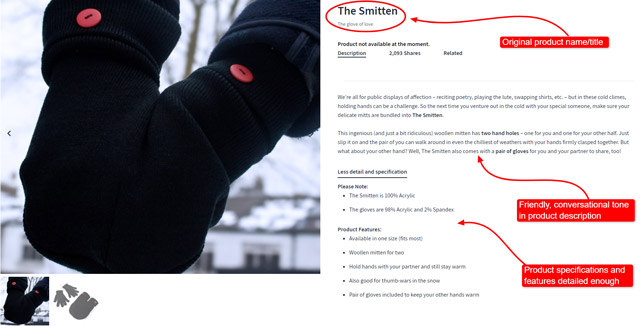
Is it really necessary to point out how original their product, the name/title, and everything else related to it actually is? We doubt it.
What else could help your product description reach the customers and the top of the search results? Here’s what you shouldn’t neglect.
Include Relevant Hyperlinks Whenever You Can
Check out how Gazebos Australia store also uses a conversational tone scattered with real product specifications, along with providing relevant inbound and outbound links in this product description.
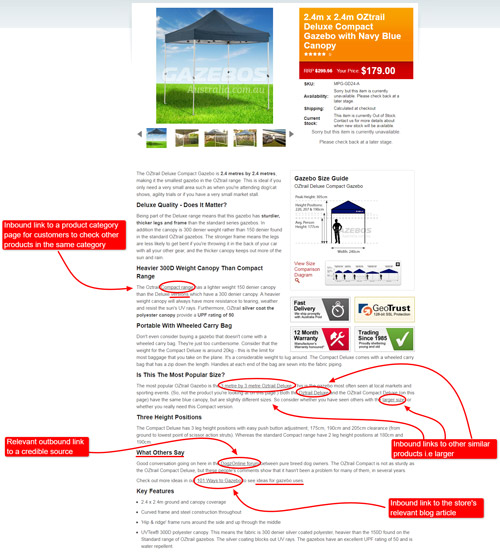
Inbound hyperlinks link to other types of content within the same website, whereas outbound ones link to other sources. Google likes to follow links so it could be a good way of improving the crawl-ability of your store for the search engines.
Highly relevant and valuable outbound hyperlinks to credible sources are always a good call. But you still wonder how to figure out which inbound links to include? Here are some hints and ideas.
Stores selling cooking utensils will sometimes link to recipes where the purchased utensil can be applied, right? Similarly, a store selling baby clothes might link to a photo gallery showing the products being worn.
Also, a store selling shoes might link to a size chart. If you’re selling tents or other camping equipment, it’s a good idea to link to some other accessories, or even a blog article that suggests e.g. top 10 family camping spots in your region.
Any additional information related to the product is welcome. So, you can link to buying guides (e.g. TV buying guide if you’re trying to sell a television), or product comparison guides (e.g. LED-LCD vs Plasma), or perhaps some technical articles if appropriate (e.g. The Ins and Outs of HDMI).
You get the point now, don’t you?
All the inbound/inline links will typically take the customer through to another page within the website, which makes them spend more time browsing the same online store. That’s how it works and that’s why they’re more than welcome.
Here’s what else can help you conquer the search engines.
Include Related Concepts
You can simply rewrite the manufacturer’s description, or write something of your own. This example below from Appliances Online shows how they have approached their product description writing.
The content is generic, but includes related keyword phrases such as “water dispenser”, “plumbing”, “auto defrost”, “fridge” and “freezer”. It’s important to include some useful keywords in your product descriptions.
You can imagine that a customer searching in Google might type in e.g. “fridge with water dispenser” so by using that same phrase in your own product description your customers are more likely to find you.
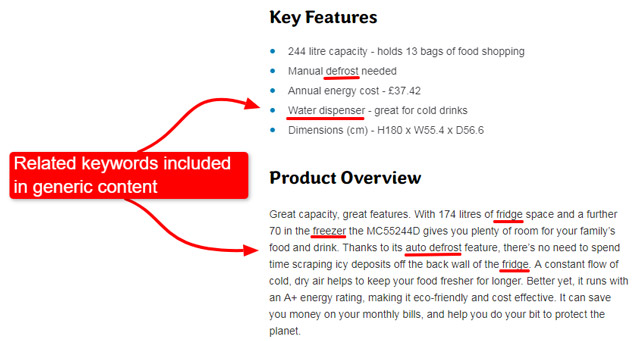
Isn’t this simple yet powerful?
When you apply all the tips we’ve discussed above, your products cannot possibly get unnoticed on the web. Is there anything else that can help you rock with your engaging product descriptions?
In Summary
To create a compelling product description to boost your sales, make sure to note the following:
- Understand why unique product descriptions are important
- Discover the features of a good quality description
- Write the product description for clarity
- Know what duplicate content looks like and avoid it
- Present easy to read content
- Get familiar with good examples
- Never stop learning from others
The impressive practical examples we’ve analysed provided some reliable, detailed guidelines on how to succeed in writing product descriptions. Here are some guidelines to stick to:
- Always include some related keywords in your product description.
- Don’t be afraid to get creative with your product descriptions. Go ahead, surprise your readers/customers.
- Feel free to use a friendly, conversational tone.
- Beware of article spinning!
- Be concise but provide enough detailed product specifications and include some related inline links to additional information.
- Use plain language and provide meaningful context when explaining technical terms. Really explain, NOT rephrase.
- Good product writing uses an inverted pyramid concept. Suggest a solution to a customer’s problem and put the summary with the key points at the very beginning of your writing.
- Keep it short and readable – only one idea per paragraph (with headings). Highlight important information.
Now, please take a look at your assignment and do the following quiz to check whether you’ve grasped the main ideas of the lecture.
